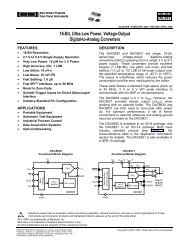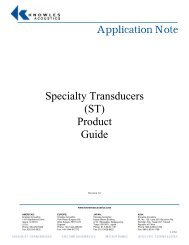AD7714* 3 V/5 V, CMOS, 500 µA Signal Conditioning ADC - dreamm
AD7714* 3 V/5 V, CMOS, 500 µA Signal Conditioning ADC - dreamm
AD7714* 3 V/5 V, CMOS, 500 µA Signal Conditioning ADC - dreamm
Create successful ePaper yourself
Turn your PDF publications into a flip-book with our unique Google optimized e-Paper software.
no longer corresponds to a full-scale reading. This allows the<br />
user to evaluate the noise performance of the part with a near<br />
full-scale voltage.<br />
DIGITAL INTERFACE<br />
The AD7714’s programmable functions are controlled using a<br />
set of on-chip registers as outlined previously. Data is written to<br />
these registers via the part’s serial interface and read access to<br />
the on-chip registers is also provided by this interface. All communications<br />
to the part must start with a write operation to the<br />
Communications Register. After power-on or RESET, the device<br />
expects a write to its Communications Register. The data<br />
written to this register determines whether the next operation to<br />
the part is a read or a write operation and also determines to<br />
which register this read or write operation occurs. Therefore,<br />
write access to any of the other registers on the part starts with a<br />
write operation to the Communications Register followed by a<br />
write to the selected register. A read operation from any register<br />
on the part (including the output data register) starts with a<br />
write operation to the Communications Register followed by a<br />
read operation from the selected register.<br />
The AD7714’s serial interface consists of five signals, CS,<br />
SCLK, DIN, DOUT and DRDY. The DIN line is used for<br />
transferring data into the on-chip registers while the DOUT line<br />
is used for accessing data from the on-chip registers. SCLK is<br />
the serial clock input for the device and all data transfers (either<br />
on DIN or DOUT) take place with respect to this SCLK signal.<br />
The DRDY line is used as a status signal to indicate when data<br />
is ready to be read from the AD7714’s data register. DRDY<br />
goes low when a new data word is available in the output register.<br />
It is reset high when a read operation from the data register<br />
is complete. It also goes high prior to the updating of the output<br />
register to indicate when not to read from the device to ensure<br />
AD7714<br />
that a data read is not attempted while the register is being updated.<br />
CS is used to select the device. It can be used to decode<br />
the AD7714 in systems where a number of parts are connected<br />
to the serial bus.<br />
The AD7714 serial interface can operate in three-wire mode by<br />
tying the CS input low. In this case, the SCLK, DIN and<br />
DOUT lines are used to communicate with the AD7714 and<br />
the status of DRDY can be obtained by interrogating the MSB<br />
of the Communications Register.<br />
Figures 6 and 7 show timing diagrams for interfacing to the<br />
AD7714 with CS used to decode the part. Figure 6 is for a read<br />
operation from the AD7714’s output shift register while Figure<br />
7 shows a write operation to the input shift register. Both diagrams<br />
are for the POL input at a logic high; for operation with<br />
the POL input at a logic low simply invert the SCLK waveform<br />
shown in the diagrams. It is possible to read the same data<br />
twice from the output register even though the DRDY line<br />
returns high after the first read operation. Care must be taken,<br />
however, to ensure that the read operations have been completed<br />
before the next output update is about to take place.<br />
The serial interface can be reset by exercising the RESET input<br />
on the part. It can also be reset by writing a series of 1s on the<br />
DIN input. If a logic 1 is written to the AD7714 DIN line for at<br />
least 32 serial clock cycles the serial interface is reset. This<br />
ensures in three-wire systems that if the interface gets lost, either<br />
via a software error or by some glitch in the system, it can be<br />
reset back into a known state. This state returns the interface to<br />
where the AD7714 is expecting a write operation to the Communications<br />
Register. This operation does not in itself reset the<br />
contents of any registers but since the interface was lost, the<br />
information which was written to any of the registers is unknown<br />
and it is advisable to set up all registers again.<br />
2<br />
DRDY<br />
CS<br />
SCLK<br />
t 4<br />
t 3 t 10<br />
t6<br />
t 5 t 7 t 9<br />
t 8<br />
DOUT<br />
MSB<br />
LSB<br />
Figure 6. Read Cycle Timing Diagram (POL = 1)<br />
CS<br />
t 11<br />
t 13<br />
t14<br />
t 16<br />
SCLK<br />
DIN<br />
t 12<br />
t 15<br />
MSB<br />
LSB<br />
Figure 7. Write Cycle Timing Diagram (POL = 1)<br />
REV. B –27–















